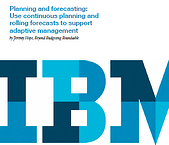Planning and Forecasting: Use continuous planning and rolling forecasts to support adaptive management
 The typical CFO presides over a performance management system involving plans, targets, and resources that are negotiated, annual, and fixed. The future outlook is increasingly unpredictable, employees are more demanding, the pace of innovation is quickening, prices are falling, customers rule suppliers, and shareholder loyalty cannot be taken for granted.
The typical CFO presides over a performance management system involving plans, targets, and resources that are negotiated, annual, and fixed. The future outlook is increasingly unpredictable, employees are more demanding, the pace of innovation is quickening, prices are falling, customers rule suppliers, and shareholder loyalty cannot be taken for granted.
To cope with these changes, CFOs need to implement systems
that provide managers at every level with the capability to make
fast and well-informed decisions.
This paper examinea how organizations and their CFOs can use such practices
to adapt to emerging threats and opportunities. Critical to this is the continous planning cycle that includes the following:
- Check. It starts with check (where are we right now?
What does the short-term future look like?) - Aim. The next step is aim. Are we on a trajectory to meet
our aspirational goals? Does our strategy need to change? - Plan. The third step is plan. What actions do we need to
take to improve our performance? What impact will these
actions have on our performance? - Act. The fourth step is act. How should we execute the plans
and manage the existing business?
Download and read "Planning and Forecasting: Use continuous planning and rolling forecasts to support adaptive management", and see how adaptive organizations see planning as a continuous, inclusive process, driven by events and emerging knowledge, and not constrained by the current financial year.


